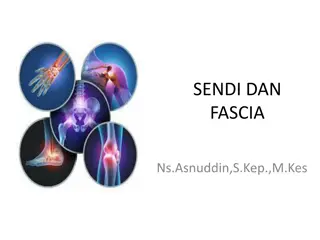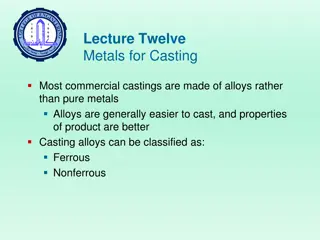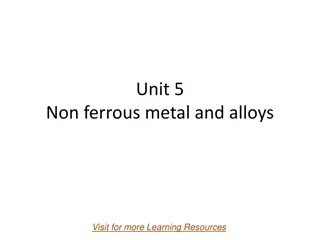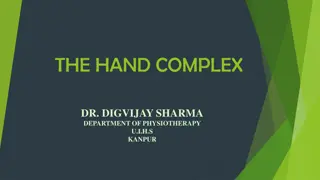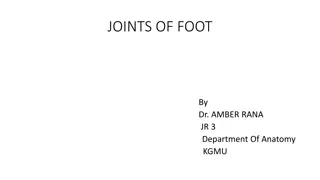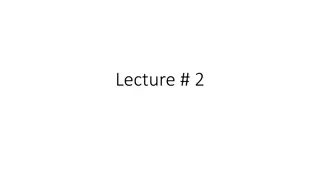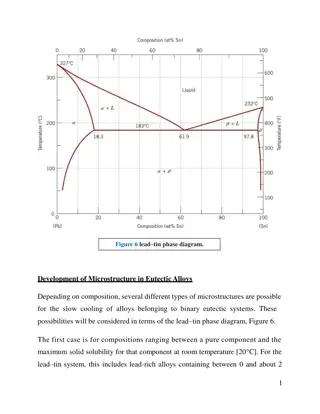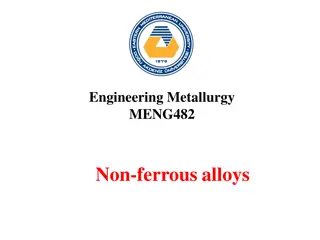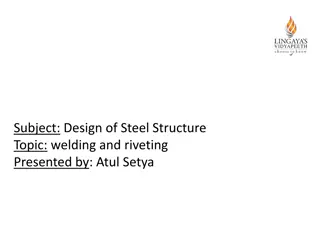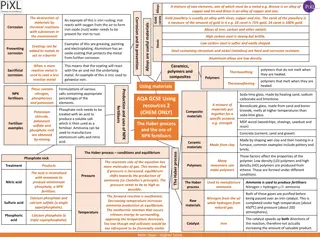Parametric Studies on Lap-Shear Joints Geometry Design for Sn-Bi Solder Alloys
Solder alloys like Sn-Bi are commonly tested with lap-shear tests to study mechanical properties and low-cycle fatigue performance. The study focuses on finite element analysis to evaluate the effects of solder joint geometry on shear deformation. It involves developing a numerical model to compare simulated and actual strain responses and analyzing the influence of parameters like solder thickness, overlap length, and substrate dimensions on Sn-Bi lead-free solder alloy.
Download Presentation

Please find below an Image/Link to download the presentation.
The content on the website is provided AS IS for your information and personal use only. It may not be sold, licensed, or shared on other websites without obtaining consent from the author.If you encounter any issues during the download, it is possible that the publisher has removed the file from their server.
You are allowed to download the files provided on this website for personal or commercial use, subject to the condition that they are used lawfully. All files are the property of their respective owners.
The content on the website is provided AS IS for your information and personal use only. It may not be sold, licensed, or shared on other websites without obtaining consent from the author.
E N D
Presentation Transcript
Project Title: Parametric studies on lap-shear joints geometry design for Sn-Bi solder alloys Solder alloys are commonly tested with lap-shear tests to study their mechanical properties or low-cycle fatigue performance. The shear stress is taken as the axial load applied divided by the solder joint area; while shear strain is the applied displacement divided by the solder thickness. Complex deformation fields are involved in such loading conditions, therefore the shear strain value can only be taken as a rough estimation. The shear behaviour reported in different studies generally varies even for identical solder composition and substrate combinations. Poor lap-shear joint geometry design may result in a large variance between far- field and nominal response of the shear behaviour of solder joints. The far-field response refers to the shear response measured by the equipment for the overall substrate-solder assembly; while the nominal response refers to the actual shear response in the solder. In this work, the finite element analysis is conducted to compare the effects of solder joint geometry on the accuracy of responses obtained from shear tests reported in the literature. A numerical model will be developed to relate the simulated and actual strain responses. The effects of solder thickness, overlap length, substrate thickness and length will be evaluated to analyse the shear deformation experienced by Sn-Bi lead-free solder alloy. Synopsis: 1. To perform numerical modelling of lap-shear solder testing using finite element analysis 2. To conduct parametric studies on lap-shear solder joint geometry Objectives: Equipment required: - Software required: ANSYS
Project Title: Effects of strain rate on Sn-Bi/Cu lap-shear solder joints Solder alloys are commonly tested with lap-shear tests to study their mechanical properties or low-cycle fatigue performance. Complex deformation fields are involved under such loading conditions, and the shear strain value is highly dependent on test parameters. The shear behaviour reported in different studies generally varies for identical solder composition and substrate combinations when loaded under different strain rate. Testing at high strain rates can simulate impact loading, while at low strain rates simulate vibrational loading. In this work, the shear modulus and strength of Sn Bi/Cu lap joint will be investigated by theoretical calculation as a function of strain rate. A numerical model will be developed to relate the simulated and actual strain responses reported in the literature. 1. To develop numerical model correlating simulated and actual strain responses of Sn-Bi/Cu lap-shear solder joints 2. To investigate the effects of strain rate on shear responses of Sn-Bi/Cu lap- shear solder joint Synopsis: Objectives: Equipment required: - Software required: ANSYS Supervisor(Department): Dr. Goh Yingxin (Mechanical) Program: Master of Mechanical Engineering Duration: Maximum 2 consecutive semesters
Project Title: Simulation of thermal cycling on Sn-Bi/Cu solder joints Tin-bismuth eutectic alloy (Sn-58 wt.% Bi) is emerging as a potential lead-free solder alternative. The low melting temperature (138oC) of this alloy makes it a suitable candidate for higher level interconnections and for soldering heat sensitive components. Investigation of thermal fatigue behaviour is one method to evaluate the strain induced when interconnections are in service. Solder joints are subjected to thermal cycling, and the resultant shear strain is the sum of linear thermal expansion of the carrier substrate and the differential thermal expansion between the solder and substrate. In this work, Sn-Bi/Cu solder joints are subjected to temperature range of 0oC to 100oC to simulate accelerated thermal cycling up to 1000 cycles. Mechanical properties will be simulated in terms of shear strength, steady state creep rate, and isothermal fatigue resistance as a function of temperature, and compared with mechanical properties reported in the literature. Synopsis: 1. To develop numerical model correlating simulated and actual thermomechanical behaviour of Sn-Bi/Cu lap-shear solder joints 2. To investigate the effects of thermal cycling on Sn-Bi/Cu lap-shear solder joint Objectives: Equipment required: - Software required: ANSYS Supervisor(Department): Dr. Goh Yingxin (Mechanical) Program: Master of Mechanical Engineering
Materials selection and design analysis of QFN packages for enhanced board level solder joint reliability Project Title: Quad Flat No-Lead (QFN) packages gained popularity in the industry during the last decade or so due to its superior thermal/electrical characteristics, low cost and compact size. QFN packages are widely used in handheld devices where space is a constraint. However, board-level solder joint reliability during thermal cycling test is a critical issue. In this work, a parametric FEA model is aimed to be developed for QFN on board with considerations of non-linear material properties of the package. Design analysis will be performed to study the effects of material properties and thermal cycling test condition. This model is expected to predict the fatigue life of solder joint during thermal cycling test to meet the industry standard for customer s use. Synopsis: 1. To simulate and validate thermomechanical behaviour of QFN package 2. To conduct parametric studies on materials selection and design of QFN package Objectives: Equipment required: - Software required: ANSYS Supervisor(Department): Dr. Goh Yingxin (Mechanical) Program: Master of Mechanical Engineering Duration: Maximum 2 consecutive semesters
Geometry design analysis of QFN packages for enhanced board level solder joint reliability Project Title: Quad Flat No-Lead (QFN) packages gained popularity in the industry during the last decade or so due to its superior thermal/electrical characteristics, low cost and compact size. QFN packages are widely used in handheld devices where space is a constraint. However, board-level solder joint reliability during thermal cycling test is a critical issue. In this work, a parametric FEA model is aimed to be developed for QFN on board with considerations of detailed pad design, realistic shape of solder joint and solder fillet, and other dimension related parameters of the package. Design analysis will be performed to study the effects of key package dimensions and thermal cycling test condition. This model is expected to predict the fatigue life of solder joint during thermal cycling test to meet the industry standard for customer s use. Synopsis: 1. To develop numerical model correlating simulated and actual thermomechanical behaviour of QFN package 2. To conduct parametric studies on QFN package geometry design Objectives: Equipment required: - Software required: ANSYS Supervisor(Department): Dr. Goh Yingxin (Mechanical) Program: Master of Mechanical Engineering Duration: Maximum 2 consecutive semesters




